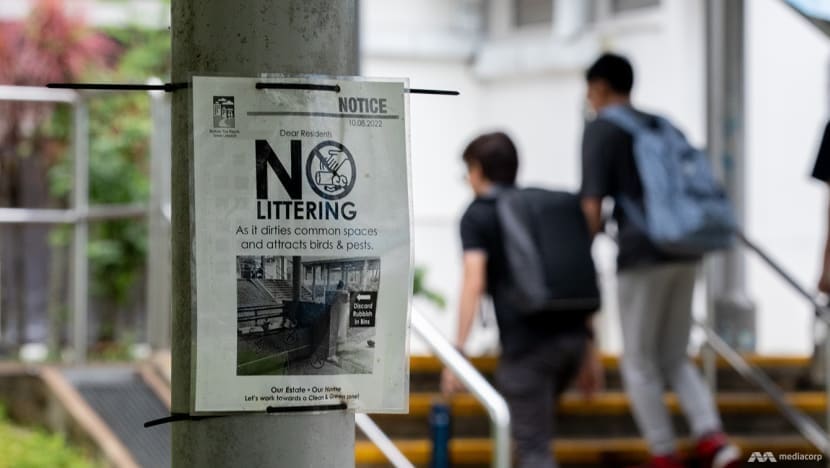Commentary: Latest push to deter litterbugs doesn’t mean we should turn against each other
When it comes to identifying litterbugs by publicising their images, there is a need for safeguards to prevent abuse and unintended consequences, says Dr William Wan of the Singapore Kindness Movement.

A notice reading ‘No Littering’ seen at Toa Payoh, on Mar 5, 2024. (Photo: TODAY/Ili Nadhirah Mansor)

This audio is generated by an AI tool.
SINGAPORE: One initiative in the recent debate on government spending estimates that created a bit of an online storm was that the National Environment Agency (NEA) may publicise the images of litterbugs so that members of the public can help identify them.
The stated objective of the proposed measure is to "invoke collective community ownership to keep the common spaces clean, and also deter potential litterbugs", according to the Ministry of Sustainability and the Environment (MSE). One concern is whether this could have the opposite effect - one that erodes social trust instead.
To reinforce the government’s commitment to a higher level of cleanliness, 2024 has been designated the year of public hygiene.
There is nothing new about the government’s obsession with keeping Singapore clean and green. Then Prime Minister Lee Kuan Yew launched the Keep Singapore Clean campaign in 1968, one of the first national campaigns to make Singapore the cleanest and greenest city in the region by addressing littering.
There had been a 15 per cent increase in feedback on ground littering from 2022 to 2023, compared to the two-year period pre-pandemic. NEA told TODAY that it had issued 18,600 tickets for ground littering in 2023.
Speaking at MSE’s Committee of Supply debate, Minister for Sustainability and the Environment Grace Fu said: “Sustaining high levels of public hygiene requires active participation of all of us.”
ADDRESSING LITTERING WITH PUBLIC ENGAGEMENT
To be fair, some of the best litter prevention campaigns from around the world succeeded precisely because they engaged the public. One recent example was the double slot “ballot bins” in Edinburgh and London.
The public voted with their rubbish and cigarette butts in light-hearted “polls”: Lionel Messi or Cristiano Ronaldo? Batman or Superman? Barbie or Oppenheimer?
The statistics of success was stunning. In Edinburgh, 90 per cent of business owners and workers were aware of the campaign. In one busy street in London, cigarette butt littering reduced by 18 per cent at one point in the campaign.
That said, the mechanism for public participation in Singapore’s plan to publish images of litterbugs is also unclear, as some netizens pointed out. What actions are expected from the public upon recognising litterbugs? Are friends and families, more likely to put a name to a face, really expected to “turn them in”? Is there a potential for conflict and the erosion of social trust if people resort to the type of “vigilantism” directed at pandemic rule-breakers?
Critics argue that broadcasting the identities of litterbugs could lead to unintended negative consequences, such as doxxing and cyberbullying. The fear is that the public humiliation might not only affect the offenders but also harm their families, potentially leading to broader social repercussions.
Given the personal and social costs involved, there is a valid concern about whether the punishment fits the crime.
LIMITING POTENTIAL OF ABUSE
Limiting public involvement in identifying recalcitrant littering offenders will help minimise the potential of abuse of so-called shame-based measures.
Senior Parliamentary Secretary for Sustainability and the Environment Baey Yam Keng also said in parliament that more closed-circuit television cameras will be deployed at hotspots that have higher offence rates and public feedback reports, in addition to increase the frequency and scale of anti-littering enforcement blitzes.
Only for those caught on camera that cannot be identified, will NEA work with community stakeholders to identify them. And only when there are still no leads, will NEA engage the wider community’s assistance in identifying them.
A clear two-step process that first engages appropriate community stakeholders could help reassure members of public concerned about the unintended consequences.
But it is important to have some safeguards in place. Who are considered appropriate community stakeholders? Will there be a rigorous selection process and how will those chosen to assist NEA be made known to the community?
The argument that no selection process is foolproof is, of course, valid. But it would certainly help to further reduce the risk of abuse.
DOING THE RIGHT THING WHEN NO ONE IS WATCHING
There is precedence in the NEA Community Volunteer Programme, in place since 2013. Volunteers are trained and empowered to engage offenders in a select range of environmental issues, assisting by taking down details of the offence and submitting them to NEA for follow-up action.
These volunteers are required to undergo a personality assessment, be familiar with the relevant laws and regulations, and pass a comprehensive test before they are issued an authorisation card that identifies them as a member of the Community Volunteer Programme.
I am one of the original members and to my knowledge, there have not been any serious undermining of mutual respect or community cohesion.
The bottom line is that maintaining a cleaner, greener and sustainable environment is for the betterment of our nation.
Civic behaviour, as I have consistently argued, is centred on us doing the right thing even when no one is watching.
When it comes to enforcing civic behaviour, thinking about publishing images of litterbugs as a fine line between surveillance and vigilantism may be too binary. There is a broad range of ways in between for the community to get involved and hold the minority of recalcitrant offenders accountable for their antisocial acts in our shared environment.
Dr William Wan is Senior Consultant, Singapore Kindness Movement.


















